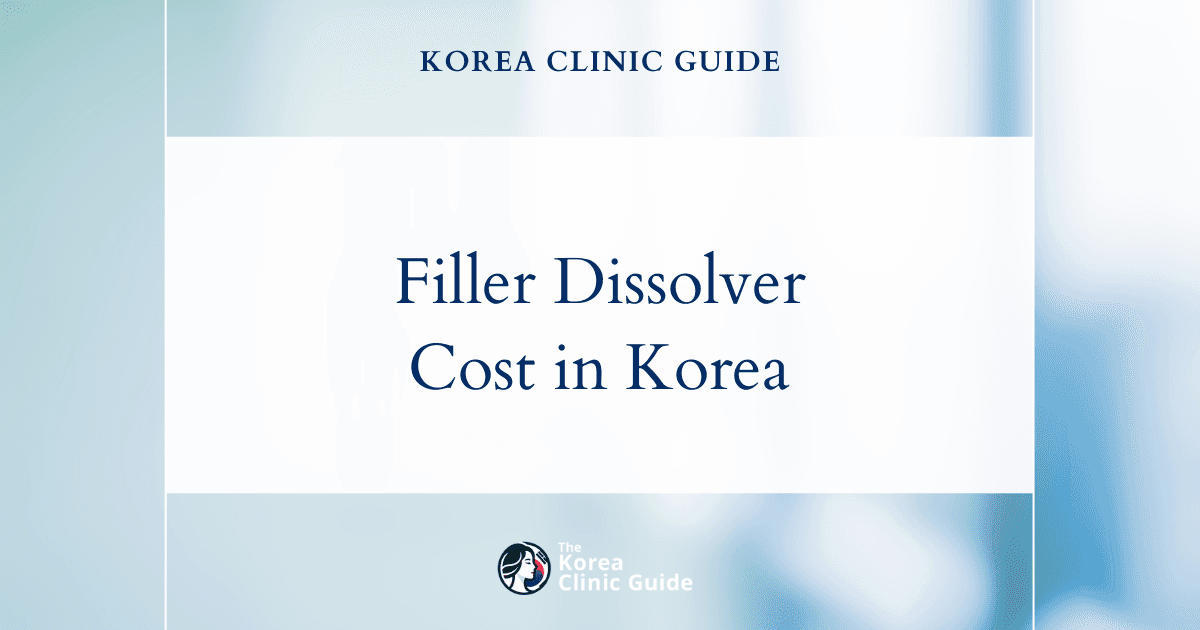Medical Tourism Blog
Laser Tattoo Removal in Korea (Seoul) | Best Clinics, Costs, Procedure Types & More

Table of contents
- What Is Laser Tattoo Removal?
- Best Clinics in Korea for Laser Tattoo Removal
- Getting Laser Tattoo Removal in Korea
- Cost of Laser Tattoo Removal in Korea
- Alternatives to Laser Tattoo Removal
- Conclusion
Are you considering erasing an old tattoo and wondering where to go for the best results? Seoul, Korea, renowned for its cutting-edge dermatological technology and skilled practitioners, has quickly become a global hub for advanced laser tattoo removal, offering exceptional care and expertise that attract clients worldwide.
What Is Laser Tattoo Removal?
Laser tattoo removal is a medical procedure designed to eliminate unwanted tattoos by employing the advanced technology of laser energy. The process works by targeting the ink particles embedded in the skin with highly concentrated beams of light. The primary goal is to break down the ink particles into smaller fragments which can then be naturally absorbed and eliminated by the body's immune system.
Laser Types
There are different types of lasers utilized in tattoo removal, with the most common being Q-switched lasers. These lasers emit light in short, powerful pulses that are effective at fragmenting the ink particles. The three most commonly used Q-switched lasers are:
- Q-switched Nd:YAG Laser: This laser is versatile, as it emits light at two different wavelengths, 1064 nm and 532 nm, making it effective for a wide range of ink colors.
- Q-switched Alexandrite Laser: Emitting light at 755 nm, this laser is particularly effective at targeting green and black inks.
- Q-switched Ruby Laser: Operating at 694 nm, this laser is suited for removing darker inks, although it is less commonly used due to advancements in Nd:YAG technology.
Treatment Process
Consultation
The first step in the laser tattoo removal process is a thorough consultation with a qualified medical professional. During this session, the practitioner will assess the tattoo's characteristics, including its size, color, age, and the depth of the ink. They will also review the patient's medical history to determine if they are a suitable candidate for the procedure.
Preparation
Before starting the treatment, the targeted area is cleaned thoroughly. Some patients may receive a topical anesthetic to minimize discomfort, although many modern lasers are designed to minimize pain.
Application of Laser
During the procedure, the laser device is applied directly to the tattooed area. The laser emits short bursts of energy that penetrate the skin and reach the ink particles. These light pulses fragment the tattoo ink into tiny particles that are small enough for the body's lymphatic system to process and remove.
Post-Treatment Care
After each session, patients are given specific aftercare instructions to promote healing and reduce the risk of complications. These may include:
- Avoiding Sun Exposure: The treated area should be kept out of direct sunlight to prevent damage and ensure optimal healing.
- Moisturizing: Applying a soothing ointment or moisturizer can help to keep the skin hydrated and promote faster healing.
- Monitoring for Infection: Patients are advised to keep an eye out for signs of infection, such as excessive redness, swelling, or discharge, and to seek medical attention if these symptoms occur.
Multiple Sessions
Complete removal of a tattoo typically requires multiple sessions, spaced several weeks apart, to allow the skin time to heal and for the body's immune system to absorb the fragmented ink particles. The total number of sessions needed varies depending on several factors, including the tattoo's size, color, and age.
Factors Affecting Success
Ink Color
Different colors of ink absorb different wavelengths of light, making some colors easier to remove than others. For example:
- Black Ink: Absorbs all wavelengths of laser light and is the easiest to remove.
- Red, Yellow, and Green Inks: These colors are more challenging as they require different wavelengths for effective removal.
Skin Type
The patient's skin type can also affect the procedure's success. Generally, lighter skin tones respond more favorably to laser treatment because there is a higher contrast between the ink and the skin. However, advancements in laser technology have made it possible to treat a wider variety of skin tones effectively.
Side Effects and Risks
As with any medical procedure, laser tattoo removal carries potential side effects and risks, although these are generally minimal. Common side effects include:
- Redness and Swelling: Temporary and usually subside within a few hours to days.
- Blistering: Minor blistering can occur but typically heals without scarring.
- Hyperpigmentation or Hypopigmentation: Changes in skin color can occur but are usually temporary and resolve over time.
In rare cases, scarring or permanent changes in skin texture can occur, making it crucial for patients to follow proper aftercare instructions and seek treatment from experienced practitioners.
Who is Laser Tattoo Removal for?
- Individuals with Unwanted Tattoos: Anyone who has a tattoo they no longer desire can consider laser tattoo removal.
- Those in Good Health: Being in good physical health is a key factor for a successful laser tattoo removal process.
- Non-Smokers: Non-smokers may experience better results, as smoking can negatively impact skin healing processes.
- People with Realistic Expectations: Candidates must have realistic expectations regarding the outcomes and understand that complete removal might not always be possible.
- Individuals Understanding Risks and Side Effects: Awareness of the potential risks and side effects, such as scarring, skin discoloration, infections, and pain, is important for anyone considering this procedure.
Best Clinics in Korea for Laser Tattoo Removal
Listed below are the best clinics in Korea for laser tattoo removal:
| Clinic Name | Key Features | Special Techniques |
|---|---|---|
| Cheongdam Oracle Dermatology & Plastic Surgery Clinic | Advanced aesthetic and medical treatments, state-of-the-art skin treatments, anti-aging, body contouring, hair restoration, plastic surgery, personalized care and safety | Latest technologies and techniques for natural-looking results, customized laser tattoo removal plans |
| Su & Mo Plastic Surgery Clinic | Advanced laser systems for tattoo removal, personalized care, comprehensive cosmetic procedures including face lifting, skin boosters, body contouring, hair restoration | Holistic approach to aesthetic medicine, tailored solutions for unique patient needs |
| Ppeum Clinic Gangnam | Team of over ten directors with Seoul National University affiliations, use of genuine products and proper dosages, advanced laser technology, wide range of aesthetic services, free online consultations | Precise and effective laser tattoo removal minimizing discomfort and downtime, collaborative research-based treatments |
Cheongdam Oracle Dermatology & Plastic Surgery Clinic
Cheongdam Oracle Dermatology & Plastic Surgery Clinic, located in Seolleung, is a leading destination for individuals seeking advanced aesthetic and medical treatments in Korea. The clinic is renowned for its comprehensive range of services, including state-of-the-art skin treatments, anti-aging procedures, body contouring, hair restoration, and plastic surgery. With a focus on delivering natural-looking results and enhancing patient confidence, Cheongdam Oracle Clinic utilizes the latest technologies and techniques to address a variety of cosmetic concerns.
For those interested in laser tattoo removal, Cheongdam Oracle Clinic stands out for its commitment to personalized care and safety. The clinic’s team of experienced dermatologists and plastic surgeons work closely with each patient to develop customized treatment plans, ensuring optimal outcomes with minimal discomfort and downtime. Whether you are looking to remove an unwanted tattoo or explore other aesthetic enhancements, Cheongdam Oracle Clinic offers a trusted and professional environment for your journey toward renewed skin and self-assurance.
Find more about this clinic here: Cheongdam Oracle Dermatology & Plastic Surgery Clinic Website
Su & Mo Plastic Surgery Clinic
Su & Mo Plastic Surgery Clinic, located in the prestigious Apgujeong district, stands out as the premier destination for laser tattoo removal in Korea due to its commitment to advanced technology, personalized care, and comprehensive expertise in cosmetic procedures. The clinic utilizes state-of-the-art laser systems to effectively break down tattoo pigments, ensuring safe and efficient removal with minimal discomfort and downtime. What sets Su & Mo apart is its holistic approach to aesthetic medicine, offering a wide array of treatments—from face lifting and skin boosters to body contouring and hair restoration—allowing patients to receive tailored solutions that address their unique needs. With a team of highly skilled professionals and a reputation for excellence in both surgical and non-surgical procedures, Su & Mo Plastic Surgery Clinic provides an unparalleled standard of care, making it the top choice for those seeking reliable and effective laser tattoo removal in Korea.
Find more about this clinic here: Su & Mo Plastic Surgery Clinic Website
Ppeum Clinic Gangnam
Ppeum Clinic Gangnam stands out as the premier destination for laser tattoo removal in Korea, thanks to its comprehensive approach to medical aesthetics and its commitment to patient safety and satisfaction. The clinic is renowned for its team of over ten directors who collaborate on joint research, many of whom are affiliated with Seoul National University, ensuring that every procedure is grounded in the latest medical advancements. Ppeum Clinic strictly adheres to the use of genuine products and proper dosages, guaranteeing both safety and efficacy in all treatments. The clinic is equipped with the most advanced laser technology, enabling precise and effective tattoo removal while minimizing discomfort and downtime. Patients benefit from a wide array of additional aesthetic services, from fillers and thread lifts to body contouring and skin rejuvenation, all offered at reasonable prices in a stylish, comfortable setting. For those considering laser tattoo removal or any other aesthetic procedure, Ppeum Clinic Gangnam provides free online consultations to help determine the most suitable treatment plan, ensuring personalized care from licensed professionals every step of the way.
Find more about this clinic here: Ppeum Clinic Gangnam Website
Getting Laser Tattoo Removal in Korea

Laser tattoo removal in Seoul, Korea is a popular and advanced medical procedure performed by highly skilled dermatologists and cosmetic surgeons. The process utilizes cutting-edge laser technology to break down the ink particles in the tattoo, which are then naturally eliminated by the body’s immune system. Here is an in-depth look at how the procedure works and what to expect when getting laser tattoo removal in Korea.
Initial Consultation
The first step in the laser tattoo removal process is an initial consultation with a qualified dermatologist or cosmetic surgeon. During this consultation, the medical professional will:
- Assess the tattoo’s size, color, location, and depth.
- Review your medical history to ensure you are a suitable candidate for the procedure.
- Discuss your expectations and the number of sessions that may be required.
Pre-Treatment Protocol
Once you have decided to proceed with the laser tattoo removal, certain pre-treatment protocols need to be followed:
- Avoid sun exposure and tanning for at least four weeks before treatment.
- Refrain from using any topical creams or medications that can increase skin sensitivity.
- Hydrate well and maintain good skin hygiene.
The Laser Treatment Process
-
Preparation of the Treatment Area:
- The skin around the tattoo area will be cleaned thoroughly.
- A topical anesthetic cream may be applied to minimize discomfort during the procedure.
-
Laser Application:
- A specialized laser device will be used to target the tattoo ink. Different wavelengths of light are used depending on the ink colors, with some lasers being more effective for certain colors.
- The laser emits pulses of high-intensity light that penetrate the skin and fragment the tattoo ink into smaller particles.
-
Cooling and Soothing:
- To manage pain and reduce skin irritation, a cooling device or cool compress is often applied.
- Topical ointments may be used to soothe the treated area immediately after the laser application.
Post-Treatment Care
After each laser session, proper post-treatment care is essential for effective healing and optimal results. This includes:
- Avoiding Sun Exposure: Protect the treated area from direct sunlight to prevent hyperpigmentation or other complications.
- Skin Care: Apply prescribed ointments and follow any skin care instructions given by your doctor to aid recovery.
- Monitoring for Side Effects: Common side effects include redness, swelling, or blistering, which typically subside within a few days. Any unusual reactions should be reported to your doctor immediately.
Frequency and Number of Sessions
The number of laser sessions required for complete tattoo removal varies based on several factors:
- Tattoo Characteristics: The age, size, color, and depth of the tattoo significantly influence the number of sessions needed.
- Skin Type: Skin types and individual healing responses can also affect the overall treatment plan.
- Ink Composition: Some tattoo inks are more challenging to remove than others, necessitating additional treatments.
Typically, patients undergo multiple sessions spaced 4 to 8 weeks apart to allow for adequate healing and effective ink fragmentation.
Advancements in Technology
Korea is renowned for its advancements in cosmetic and dermatological procedures, including laser tattoo removal. Clinics often utilize the latest laser technologies, such as Q-switched lasers and PicoSure lasers, which offer more precise and efficient treatment with minimal discomfort and faster recovery times.
Risks and Considerations
While laser tattoo removal is generally safe, it is essential to be aware of potential risks and side effects:
- Scarring: There is a slight risk of scarring, particularly if pre-and post-treatment care instructions are not followed diligently.
- Pigmentation Changes: Hypopigmentation (loss of skin color) or hyperpigmentation (darkening of skin) can occur, especially in individuals with darker skin tones.
- Infection: Proper wound care is crucial to prevent infections.
Overall, choosing a reputable clinic with experienced professionals can significantly minimize these risks.
Cost of Laser Tattoo Removal in Korea
When considering laser tattoo removal, it is essential to evaluate the costs involved, especially when comparing different countries. In Seoul, Korea, laser tattoo removal is not only widely available but also comparatively affordable due to the high demand and advanced technological infrastructure in the cosmetic treatment sector.
Laser Tattoo Removal Costs in Korea
In Seoul, Korea, the cost of laser tattoo removal ranges between $100 to $500 per session, depending on the size, color, and complexity of the tattoo. Multiple sessions are often required to achieve complete removal, typically ranging from 5 to 10 sessions. Korean clinics often offer package deals that can lower the per-session cost, making it more economical for patients.
Laser Tattoo Removal Costs in the USA
By comparison, in the USA, laser tattoo removal is generally more expensive. The cost per session ranges from $200 to $700. Factors influencing the price include the geographic location of the clinic, the expertise of the dermatologist or technician, and the specific laser technology being used. As in Korea, multiple sessions are necessary, leading to higher overall costs.
Laser Tattoo Removal Costs in Other Countries
- United Kingdom: In the UK, the cost per session typically ranges from £150 to £500 ($200 to $650). Similar to the USA, the final cost is influenced by location, clinic reputation, and the technology used.
- Australia: Australians can expect to pay between AUD 100 to 500 ($70 to $350 USD) per session, with factors such as clinic location and tattoo specifics affecting the price.
- Canada: In Canada, the cost per session is usually between CAD 200 to 500 ($150 to $370 USD). Again, geographic and clinic-specific factors play a significant role in the price determination.
- Japan: In Japan, prices vary widely but generally range from ¥10,000 to ¥50,000 ($90 to $450 USD) per session, reflecting the high quality of medical services and advanced technology used.
Factors Affecting Cost in Different Countries
Several factors impact the cost of laser tattoo removal across different countries, including:
- Technological advancements: Countries with access to the latest laser technology may charge higher fees due to the improved efficacy and safety of newer equipment.
- Expertise: Dermatologists or technicians with specialized training and experience may command higher prices for their services.
- Market Demand: High demand for cosmetic procedures can lead to competitive pricing, as seen in Korea.
- Healthcare Regulations: Countries with stringent healthcare regulations might have higher operational costs, influencing the overall price of laser tattoo removal services.
Taking these factors into account, Korea stands out as a cost-effective option for laser tattoo removal without compromising on quality or safety.
Alternatives to Laser Tattoo Removal
Effective tattoo removal can be achieved through various methods in addition to laser therapy. Here are three suitable alternatives for those considering different options:
Dermabrasion
Dermabrasion is a surgical procedure that involves using a high-speed rotary instrument to "sand" down the top layers of the skin. This method effectively scrapes away the skin layers containing the ink particles.
How It Works:
- Procedure: A specialized tool with an abrasive wheel or brush is used to remove the outer layers of the skin.
- Anesthesia: Local or general anesthesia is administered to manage pain during the procedure.
- Recovery: After the procedure, the skin is left with an open wound that needs proper healing time and care to avoid infection.
Benefits:
- Can be effective for removing superficial tattoos.
- Suitable for people with certain skin types where laser removal is less effective.
Risks:
- High risk of scarring.
- Possible infections and skin irritation during healing.
- Requires substantial aftercare.
Chemical Peels
Chemical peels utilize chemical solutions like trichloroacetic acid (TCA) to remove the upper layers of the skin where tattoo ink is located.
How It Works:
- Procedure: A dermatologist applies a chemical solution to the tattooed area, causing the skin to blister and eventually peel off, removing the ink-containing layers.
- Application: Multiple sessions may be required.
- Recovery: The skin will be sensitive and may be red and swollen after each session. Proper care is needed to facilitate healing.
Benefits:
- Less invasive compared to surgery.
- Can gradually fade tattoos over several treatments.
Risks:
- Skin irritation and redness.
- Potential for chemical burns or over-peeling.
- Risk of permanent discoloration and scarring.
Surgical Excision
Surgical excision involves the physical removal of tattooed skin, followed by stitching the surrounding skin back together.
How It Works:
- Procedure: A surgeon cuts out the tattooed skin. For larger tattoos, skin grafting may be necessary.
- Anesthesia: Performed under local or general anesthesia depending on the size of the tattoo.
- Recovery: Requires stitches and a period of healing. Scar formation is inevitable.
Benefits:
- Effective for complete removal, especially for small tattoos.
- Quick procedure with immediate results.
Risks:
- Visible scarring is inevitable.
- Not practical for large tattoos.
- Surgical risks such as infection and poor wound healing.
Each of these methods has unique advantages and disadvantages. Consulting with a certified dermatologist or healthcare provider is crucial to determine the most appropriate treatment based on individual skin type, tattoo characteristics, and personal health considerations.
Conclusion
In conclusion, laser tattoo removal in Seoul, Korea stands out for its advanced technology, skilled professionals, and comprehensive aftercare services. The country has become a sought-after destination for individuals looking to safely and effectively remove unwanted tattoos, thanks to its cutting-edge clinics and stringent medical standards. Whether driven by personal reasons or professional requirements, those considering tattoo removal can take confidence in Korea's reputation for excellence in cosmetic and dermatological treatments. Thus, choosing Korea for laser tattoo removal not only promises outstanding results but also ensures a high standard of patient care and satisfaction.















